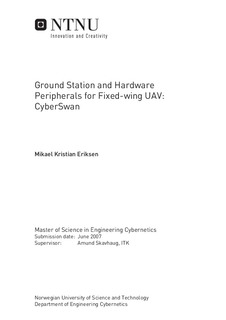Ground Station and Hardware Peripherals for Fixed-wing UAV: CyberSwan
Master thesis
Permanent lenke
http://hdl.handle.net/11250/259870Utgivelsesdato
2007Metadata
Vis full innførselSamlinger
Sammendrag
In this master's thesis, a ground station (GS) for the fixed-wing UAV: CyberSwan (CS), has been developed. The CS was designed for surveillance purposes, and two other master's theses deals with the work of making it autonomous (Høstmark (2007) and Bjørntvedt (2007)). Having a GS will make it possible to communicate with the CS in-flight, and present data and video from the CS through communication devices. The GS has been realised using LabVIEW development software from citet{labview}. A CS simulator was also developed in LabVIEW for test purposes. In addition was a Global Position System (GPS) receiver board, and a Radio Frequency (RF) communication board, developed. The GPS receiver was used to position the GS, and used as a source for position correction data. The RF communication board was developed for mounting in the CS and to be connected to its computer system to enable communication with the GS. The GS used a RF demo board for communication. A wireless camera was mounted on the CS for in-flight video surveillance, and a ultrasound ranging device was tested intended to be used in a autonomous landing situation. A hardware in the loop (HIL) test was performed to test the GS's communication capacity. Here the developed CS simulator was used, as the CS computer system was not completed (Bjørntvedt 2007). The test proved it possible to transfer a CS status message at 4 Hz, making the chosen communication device a good choice for the intended purpose.
